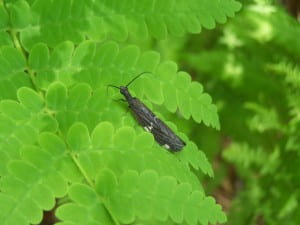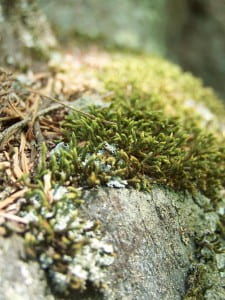In a short amount of time, undergraduate student, Aaron Groves, and I were able to trek over to Point au Sable and perform just one point count along the shoreline before the downpour of rain began! Upon arriving at the Point, we noticed that the landscape had changed drastically since we had last been there a few months ago. The shoreline was completely covered in the invasive Phragmites australis, making it nearly impossible to view the bay of Green Bay. Regardless, many of the small passerines did not seem to mind this invasive. We found numerous Black-capped Chickadees, Song Sparrows, and one Myrtle (Yellow-rumped) Warbler foraging within the Phragmites and using it for cover. We also observed the following species: Great Egret, Great Blue Heron, Mallard Duck, Canada Geese, Ring-billed Gull, Red-winged Blackbird, Common Grackle, Ovenbird, Downy Woodpecker, Gray Catbird, White-breasted Nuthatch, American Crow, Blue Jay, and American Robin. Upon hearing the chatter of the Belted Kingfisher and the ever-present European Starling, the rain slowly started to pour, at which point Aaron and I left for the day. We observed a total of 19 species.
Author: Erin Gnass
Brown, Kewaunee, Shawano, and Oconto Bird Surveys: May 26 to June 24, 2010 by Erin Gnass
As I mentioned in one recent blog posting entitled “May 26, 2010 by Erin Gnass,” I performed bird surveys for the greater part of the month of June for my thesis project—the index of ecological condition model, as applied to northern hardwood forests of Wisconsin. In order to most appropriately create this model, I surveyed additional hardwood forested sites considered to be of poorer forest condition so as to sample across a wide range of environmental condition. This enables the model to be more accurate and effective at calculating forest condition. Therefore, I went in search of hardwood forest sites on both public and private lands near and within heavily managed, fragmented, and human-disturbed or developed areas. Within Brown, Kewaunee, Shawano, and Oconto counties here in east-central Wisconsin, I found 27 sites that I surveyed, with the much-appreciated assistance of Joan Berkopec (the same wonderful volunteer who helped with the Wild Rivers Legacy Forest surveys and the Nicolet National Forest Bird Survey that I described in the two previous posts).
From May 26 until June 24, I observed 49 total species at these 27 additional sites, including the following species of interest:
Seven warblers: Chestnut-sided, Common Yellowthroat, Mourning, Northern Waterthrush, Ovenbird (in moderate numbers), Pine, and Yellow Warblers
Seven woodpeckers: Downy, Hairy, Northern Flicker, Pileated, Red-bellied, Red-headed, and Yellow-bellied Sapsucker Woodpeckers
Four flycatchers: Eastern Phoebe, Eastern Wood-Pewee (in moderate numbers), Great Crested (in moderate numbers), and Least Flycatchers
Three thrushes: American Robin (in moderate numbers), Veery, and Wood Thurshes
And one vireo: Red-eyed Vireos (in large numbers)
Please feel free to look at the photographs that I took shown below:


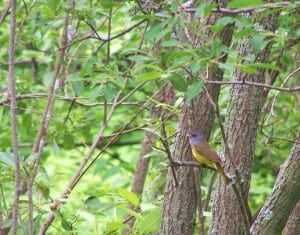

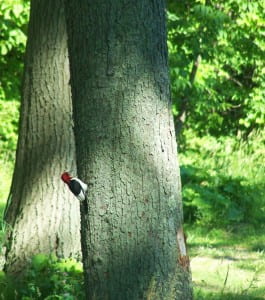

Thank you to professional photojournalist, Scott Giese, my boyfriend, for taking these additional photographs of me while I completed a bird survey in Brown County:


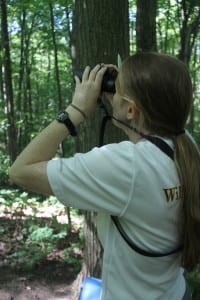
June 11-13, 2010: Nicolet National Forest Bird Survey by Erin Gnass
Every year since 1987, a large group of ornithologists have performed breeding bird surveys within the Nicolet National Forest (NNF; see the Nicolet National Forest Bird Survey: (http://www.uwgb.edu/birds/nnf/) in northeastern Wisconsin, now contributing to well over 40,000 records of birds consisting of over 200 total bird species. Whether you are an ornithologist by profession, a volunteer, a student, a back-yard birder, the state’s best expert, or a complete novice who has never seen a Canada Goose in your life, absolutely anyone can come and assist in the survey! Luckily, I was able to be one of the group leaders and engage myself in the survey for the very first time. Having heard about how much fun and exciting it is to participate in such a wonderful annual event, I was not disappointed in the slightest!
On the first day of the survey, I led a small team birders consisting of a young couple and another woman to pine and hardwood forests and a few beautiful bogs. Although the sites were not as biodiversity rich as other sites within the Nicolet National Forest, we were able to observe many interesting but “usual suspect” birds, such as the Ovenbird, Red-eyed Vireo, Chipping Sparrow, Eastern Wood-Pewee, Rose-breasted Grosbeak, American Robin, Brown Creeper, Blue Jay, Black-capped Chickadee, Black-throated Green Warbler, Alder Flycatcher, Yellow-bellied Sapsucker, and many others. After this first morning of surveys, a large group of us, including (some of my favorite ecologist/biologist friends) UWGB undergraduate student, Aaron Groves, former UWGB Environmental Science & Policy graduate student, Kathryn Corio, Ron Eichhorn (who helped the Nature Conservancy and me with the WRLF project), and a few others went out to a bog near the NNF to look for interesting plants and birds. A few of us chased down a Palm Warbler while others observed uncommon plant species. Please see the photographs that I took down at the bottom of this posting. Thank you to all of the botanists in this group who showed me these beautiful plants.
On the second day, graduate student, Nick Walton, joined our group and helped to lead the surveys. Near the end of one of the last surveys of the day, we heard a nearby soft chickadee-call where we discovered two Boreal Chickadees—the highlight of my entire summer. Not only did these individuals continue singing throughout the remainder survey, they flew low in the trees only ten meters away from us for quite a few minutes. Not many people have the opportunity to view this species in particular because they are considered an uncommon, northern U.S./Canada dwelling species. Thus, when we shared the news with other birders upon returning to the field houses, everyone expressed their surprise and excitement to us. What a thrilling day it was.
I look forward to next summer’s bird surveys at the Nicolet National Forest.
My photographs:
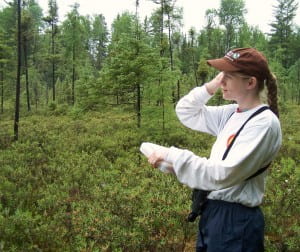





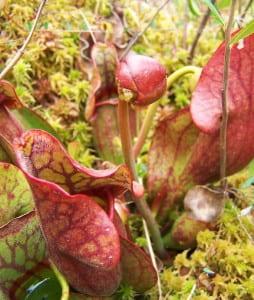
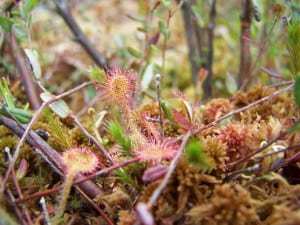

May 30 to June 5, 2010: Wild Rivers Legacy Forest by Erin Gnass
One of the many exciting bird research projects that I helped to investigate this summer was with the Nature Conservancy (TNC) in the Wild Rivers Legacy Forest (WRLF) north of Armstrong Creek in northern Wisconsin. With a field crew of eight people, many of us living in one field house, we not only gathered very useful bird survey data for TNC and my graduate thesis project, but we were also fortunate enough to listen to and observe many unique and beautiful bird species. Every afternoon or evening, we met as a group to decide how to break apart all of the required bird survey sites within the forest. Some of us went out in pairs while others surveyed independently to perform as many bird point counts as possible between the half hour prior to dawn until 9:30 AM (the short window of time that breeding birds are allowed to be surveyed). Depending on the terrain, distance between points (via car or on foot), and weather, many pairs or individuals performed as few as 5-6 surveys to as many as 12 in a morning! Therefore, we finished all 200 bird survey sites in the WRLF and the 23 additional sites of poor ecological forest condition in one week’s time!
For some of the bird sighting highlights of this week during the first week of June, we viewed 73 total species within the WRLF including:
16 warblers: American Redstart, Black-and-white, Blackburnian (in large numbers), Black-throated Blue, Black-throated Green (in large numbers), Canada, Common Yellowthroat, Chestnut-sided, Magnolia, Mourning (in large numbers), Myrtle (the official name of the eastern population of the Yellow-rumped Warbler), Nashville, Northern Parula, Northern Waterthrush, Ovenbird (in large numbers), and Tennessee Warblers
Six flycatchers: Eastern Kingbird, Eastern Phoebe, Eastern Wood-Pewee (in large numbers), Great Crested, Least (in large numbers), and Yellow-bellied Flycatchers
Six woodpeckers: in comparison to last year’s data, we observed many more woodpecker individuals: Downy, Hairy, Northern Flicker, Pileated, Red-bellied, and Yellow-bellied Sapsucker (in large numbers) Woodpeckers
Five thrushes: American Robin (in large numbers), Hermit Thrush (in large numbers), Swainson’s, Veery, and Wood Thrushes
Four birds of prey: Broad-winged Hawk, American Kestrel, Barred Owl, and Red-shouldered Hawk
Two vireos: Red-eyed (in large numbers) and Blue-headed Vireos
And several other birds of interest included: Black-billed Cuckoo, Black-capped Chickadee (in large numbers), Blue Jay (in large numbers), Brown Creeper, Common Raven, Chimney Swift, Evening Grosbeak, Indigo Bunting, Purple Finch, Rose-breasted Grosbeak (in large numbers), Red-breasted Nuthatch, Scarlet Tanager (in large numbers), White-breasted Nuthatch, White-throated Sparrow (in large numbers), Winter Wren, and Yellow-billed Cuckoo.
In comparison to the 200 sites of the WRLF, we only observed 47 total species within the sites of poor ecological forest condition, including many of those observed within the WRLF. In these additional sites, however, we also observed the Eastern Bluebird, Eastern Meadowlark, Golden-winged Warbler, Ring-necked Pheasant, and Yellow-throated Vireo, which were not observed during point counts in the WRLF.
For fun in the afternoons, we would gather for lunch at a nearby lake, such as Savage Lake, and enjoy the Black Terns, Sandhill Cranes, and Common Loons, which foraged within a few hundred meters of us. Other days we searched for different bird species (e.g. Bobolink) and other walks of life, such as dozens of dragonfly species, as expertly identified by Ron and Joan. We ran into several deer and quite a few black bears, including one close call during a survey that I was conducting by myself. Around minute three of one ten-minute bird point count survey that I was doing, a large black bear peered through thick brush about 25 meters away from me. After shooing it away from me, it still remained close, only about 200 meters away. Upon completing the bird survey and heading back to my car, it stood on its back legs and kept a close watch over me! Thankfully, it continued to forage and stay clear of me.
In one short week’s time, our dedicated and tireless field crew performed many surveys, which provided this study with incredibly useful data that will contribute towards a vastly important conservation project for the future. Luckily, I had some of the most fun that I have ever had working on a bird field crew and am grateful to be a part of this project. Thank you to all of those expert birders on this crew who helped me to become a better birder!
Please take a look at some of the photographs that I took during this week.
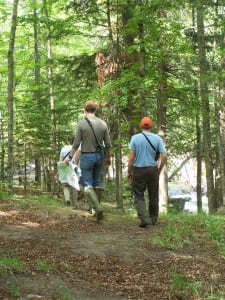
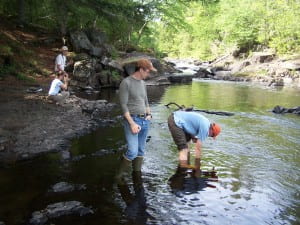
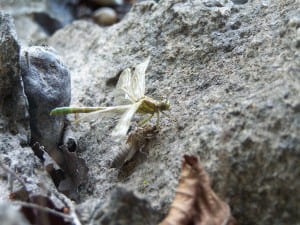

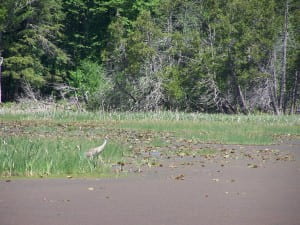

Nature Conservancy Bird Survey: May 26, 2010 by Erin Gnass
Because I have been in the process of preparing for my graduate thesis field work this summer, I have not had a chance to perform any additional bird surveys at Point au Sable. I will be heading to the northern hardwood forests of Wisconsin on Saturday to assist in performing over two-hundred bird surveys with the Nature Conservancy (TNC) for my thesis research. For my thesis project, I am developing a probability-based ecological indicator model for over 65,000 acres of forested land that is managed by TNC, the state of Wisconsin, and timber investment management organizations in the Wild Rivers Legacy Forest (WRLF). Based on an environmental gradient (ranging from degraded to pristine forest conditions), this ecological indicator will utilize the presence and absence of assemblages of bird species to indicate the ecological condition and conservation health of the forested lands of the WRLF. This indication of ecological condition will provide timber managers within the WRLF assistance in monitoring and managing these forests in a sustainable manner for both humans and wildlife.
In preparation for the model, TNC surveyed sites in the northern hardwoods of Wisconsin for forest bird species in the summer of 2009. This summer, I will be fortunate enough to join the team of ornithologists and survey the same sites as well as others, starting this Sunday. Additionally, in order to survey sites across the entire environmental gradient, my graduate advisor, Dr. Bob Howe, and I are surveying additional areas of varying forest condition including fragmented, isolated, and/or human-used areas in the Brown County area in order to most appropriately create this ecological indicator model. Therefore, we started these additional surveys yesterday morning in areas including and surrounding Brown County. All of this data will then ultimately contribute towards the conservation, protection, and sustainable use of northern Wisconsin hardwood forests.
Yesterday, we went to the managed forests of the Reforestation Camp in Suamico, Wisconsin and found 31 total bird species, including many species of particular interest: Mourning Warbler, Northern Waterthrush, Pileated Woodpecker, Scarlet Tanager, Veery, and Yellow-bellied Sapsucker. We also found American Crow, American Goldfinch, American Robin, Black-capped Chickadee, Blue-gray Gnatcatcher, Brown-headed Cowbird, Blue Jay, Canada Goose, Common Yellowthroat Warbler, Downy Woodpecker, Eastern Wood-Pewee, Great Crested Flycatcher, Gray Catbird, Hairy Woodpecker, House Wren, Indigo Bunting, Mourning Dove, Northern Cardinal, Ovenbird, Red-bellied Woodpecker, Red-eyed Vireo, Red-winged Blackbird, Sandhill Crane, White-breasted Nuthatch, and Wild Turkey.
Although I will be in northern Wisconsin for the next few weeks, I will provide a few reports about my thesis work and the annual Nicolet National Forest Bird Survey (June 11-13) when I return to Green Bay. Then, once I am back from field work, I will survey Point au Sable again and provide weekly updates. So please stay tuned!
Point au Sable Bird Survey: May 17, 2010 by Erin Gnass
With bright sunshine, nearly 60 degrees in temperature, and northerly winds over the weekend, we found many new species and the most total species observed for the season in one morning-a total of 59 species! We observed approximately a dozen Common Goldeneyes performing mating rituals off shore near a few American White Pelicans. A dozen Double-crested Cormorants, Canada Geese, Mallard Ducks, and screeching Caspian Terns passed along shore and overhead through the morning. Spotted Sandpipers and Sandhill Cranes also continue to use the Point. Despite many of the interesting species we observed today, we found a few broken American Robin egg shells, which we have found a few times around the Point. Sadly, the eggs might have blown out of different pair’s nests during some intense wind or rain storms that we have had this April and May.
Of the newest arrivals were Red-eyed Vireos, Yellow-throated Vireos, Least Flycatchers, and Yellow-bellied Flycatchers! While I stumbled upon a Northern Waterthrush out in the open, Aaron spotted our season’s first Black-billed Cuckoo high in an aspen tree, laying fairly still along a branch. We later found it lower in a shrub, perhaps resting after arriving to the Point overnight. And one short of our record of total warbler species observed in one day for the season, we observed 13 total warbler species this morning, including Northern Waterthrush, Tennessee, Golden-winged, Magnolia, American Redstart, Palm, Blackburnian, Yellow, Yellow-rumped, Common Yellowthroat, Black-and-white, Ovenbird, and Nashville Warblers. We continue to observe Warbling Vireos, Rose-breasted Grosbeaks, Swamp Sparrows, Blue-gray Gnatcatchers, House Wrens, Bald Eagles, Baltimore Orioles, Song Sparrows, and many more interesting and magnificent species of birds.
Observers: Erin Gnass and Aaron Groves (Thank you very much, Aaron, for accompanying and helping me this spring season and best of luck with your Cofrin student research summer field work!)
Point au Sable Bird Survey: May 14, 2010 by Erin Gnass
Although the morning started out a little chilly at the Point, it didn’t take very long for the air to warm and the birds to start singing and being active. Shortly after arriving and completing our first bird survey, a season’s first, beautiful white Great Egret flew over the Bay and landed within twenty five meters of us! It quickly began to forage along shore looking for fish and then flew further down the shoreline, at which point I was able to photograph this elegant bird. Additionally, we found ten species of warbler, including our season’s first Chestnut-sided and large numbers of Common Yellowthroat, Yellow, Yellow-rumped, and Palm. In fewer numbers but just as wonderful, we found Cape May, Blackpoll, Black-throated Green, Black-and-white, and Ovenbird warblers.
Throughout the entire Point, we found many regular, abundant species including House Wrens, Blue-gray Gnatcatchers, Chimney Swifts, and Gray Catbirds. Although less abundant, we also observed a few rather conspicuous Rose-breasted Grosbeaks, Warbling Vireos, and Swamp Sparrows. Around the same area that we were walking two days earlier, we observed and heard a melodious Wood Thrush near the center of the Point within dense vegetation. We also observed large numbers of Tree, Barn, and Northern Rough-winged Swallows foraging for flying insects off shore and near the center of the Point. All together, we recorded 40 species.
Observers: Erin Gnass, Aaron Groves, and Ashley Fehrenbach
Photographs by me:


Point au Sable Bird Survey: May 12, 2010 by Erin Gnass
Despite how cold it was upon arriving at the Point, we found the forest and shoreline to be quite active with many new and exciting season’s first migrant bird species! We were incredibly fortunate to stumble upon some very interesting species: Spotted Sandpiper (three different individuals around the Point), Blackpoll Warbler, American Redstart, Swainson’s Thrush, Wood Thrush, Chimney Swift, Cliff Swallow, and White-crowned Sparrow! Although much lower in numbers, Yellow-rumped and Palm Warblers continue to forage and use the Point as they pass through the Green Bay-area and head north for the breeding season. House Wrens, Warbling Vireos, Blue-gray Gnatcatchers, Common Yellowthroats, Yellow Warblers, and Tree Swallows, however, were still quite abundant and observed at several different locations around the Point.
Observers: Erin Gnass, Kari Hagenow, and Aaron Groves
Note: Nick Walton will no longer be assisting with the Point au Sable surveys for the season because he has headed north for his summer field work searching for and monitoring the nests of the Great Lakes endemic, Kirtland’s Warbler! He will return later in the summer and fall to continue surveying the birds at the Point.
Some photographs, taken by me:



Bird Banding at Point au Sable: May 6, 2010 by Erin Gnass
Luckily, Dr. Bob Howe took the UWGB Ornithology class to Point au Sable again to set up the bird banding station for the last class field trip. With spring migration moving along, we captured seven individual birds, of five different species: three Ovenbirds, one White-throated Sparrow, one Northern Cardinal, one Yellow-rumped Warbler, and one Sharp-shinned Hawk. Therefore, the class was able to gain a new perspective on identifying bird species by seeing them up close. In addition to those species, numerous others foraged and traveled through the area, including Cape May Warblers, Black-and-white Warblers, Yellow-rumped Warblers, Black-throated Green Warblers, Pine Warblers, Scarlet Tanagers, Blue-headed Vireos, Red-tailed Hawks, House Wrens, Great Crested Flycatchers, Forster’s Terns, and many more.
Thanks to Kari Hagenow, I am able to share a few photographs taken of the birds caught at the banding station:






May 5, 2010 by Erin Gnass
Finally, spring migration has picked up the pace in bringing Point au Sable some new migratory birds! Right along the shoreline, we observed two Greater Yellowlegs (season’s first!), Killdeer, Barn Swallows, Northern Rough-winged Swallows, Tree Swallows, and Purple Martins. A few Common Goldeneyes and Scaup were still foraging offshore along withCaspian Terns, American White Pelicans, Double-creasted Cormorant, Herring Gulls, and Canada Geese.
Of particular interest, we had a number of season’s first species including: Blue-winged Warbler, Golden-winged Warbler, Blackburnian Warbler, Northern Parula, Yellow Warbler, Common Yellowthroat Warbler, Nashville Warbler, Rose-breasted Grosbeak, Gray Catbird, Warbling Vireo, and Baltimore Oriole.
In addition to these new migrants, we also observed several other species that continue to inhabit the beautiful Point au Sable: Black-throated Green Warbler, Yellow-rumped Warbler (in large numbers), Palm Warbler, Blue-gray Gnatcatcher, House Wren, Ruby-crowned Kinglet, Blue Jay, Chipping Sparrow, Song Sparrow, White-throated Sparrow, American Robin, Red-winged Blackbird, White-breasted Nuthatch, Red-breasted Nuthatch, American Goldfinch, Black-capped Chickadee, Downy Woodpecker, and Northern Cardinal. We had quite a day, totaling 38 species.
Observers: Erin Gnass, Nick Walton, Ashley Fehrenbach, and Kari Hagenow

